
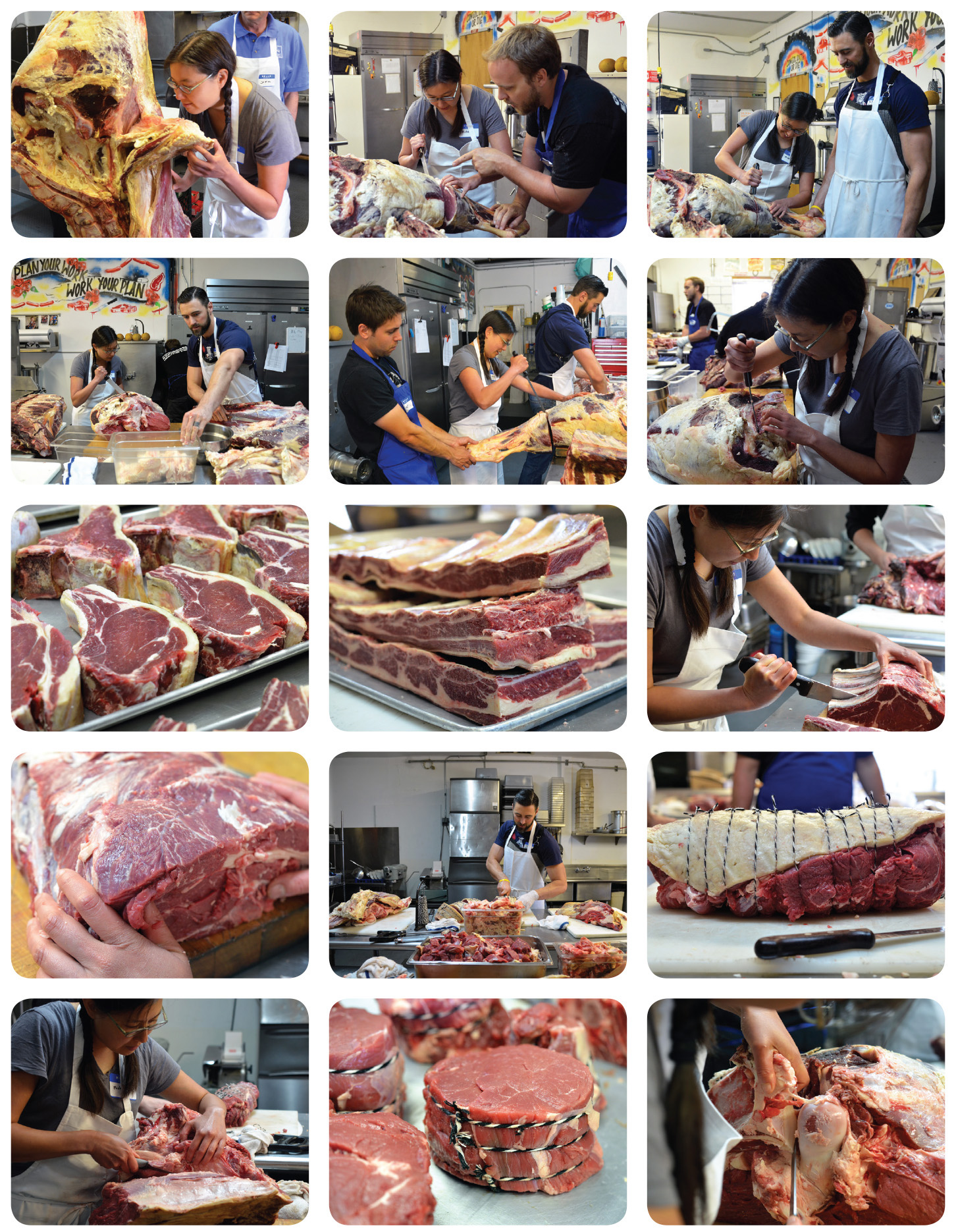
Ryan Farr and Kent Schoberle of San Francisco's 4505 Meats taught me and my pal Dallas how to butcher a steer!

I LOVE ANIMALS. THEY’RE DELICIOUS.
Scientists agree: humans evolved to eat meat. So for optimal health, I include a healthy amount of it in my diet.

Eating meat isn’t just good for you; it can be ethical and sustainable, too. Just try to stick to the highest possible standards that your pocketbook can accommodate. Buy your meat from local farms and farmer’s markets, or join a cowshare or a Community Supported Agriculture (CSA) program that offers farm-fresh pick-ups or deliveries. After all, the food we put in our bodies has a huge impact not just on our health, but on our environment as well.
If you’re prioritizing your protein purchases, put grass-fed, sustainably raised beef, lamb, goat, and venison at the top of your list. Whenever possible, make sure your grass-fed meat is grass-finished, too; otherwise, “grass-fed” could just mean that the animal was fed the unholy triumvirate of soy, wheat, and corn as soon as it was old enough to be crammed into a feedlot at a factory farm.
The meat of grass-fed ruminants can be pricy, so when you spot a sale or discount, stock up on as many different cuts as you can haul away in the trunk of your car: steaks, ribs, roasts—you name it. Tougher cuts are cheaper, and can be slow-cooked or pressure-cooked to tender perfection. Make sure you have plenty of ground beef, too. It can come in handy when you need to whip up a quick dinner.
Pigs aren’t “grass-fed” because they aren’t vegetarians, but with a bit of extra effort, you can find pasture-raised pork. Avoid pigs that are raised on garbage and chemical injections, and get the ones that eat what nature intended.
Do your best to get the good stuff, but if you’re stuck with conventionally-raised, grain-fed meat, don’t freak out. Just choose lean cuts and trim off the excess fat. (The fat profile of factory-farmed animals is less than optimal.)
One final tip: get yourself an extra freezer. A big one. 

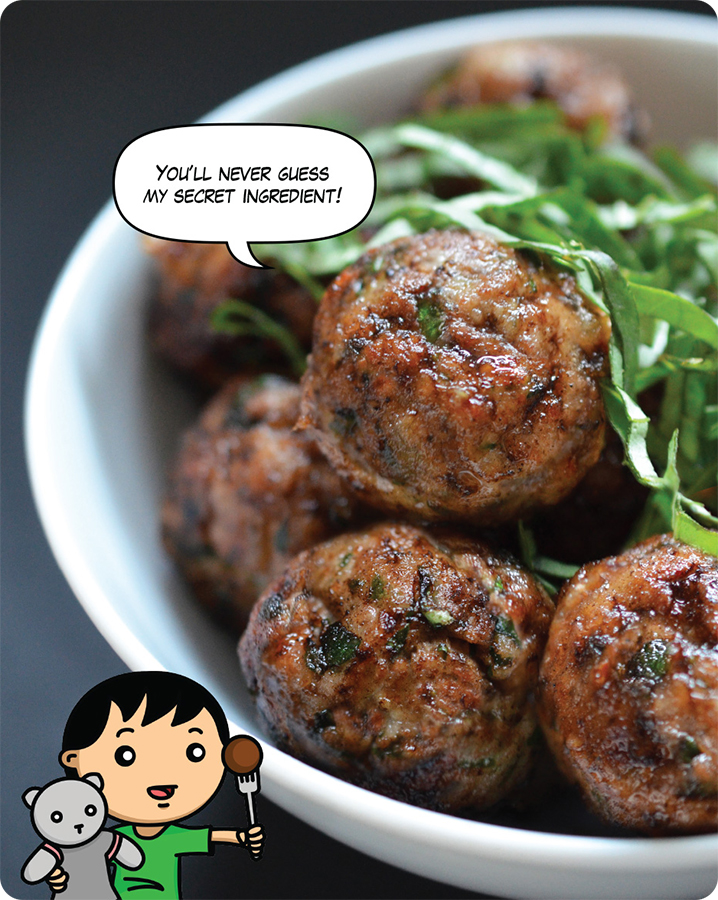
Close your eyes and imagine a meatball. Are you picturing a humongous orb of “imbreaded” meat drowning in spaghetti sauce? Well, don’t. Classic Italian polpette are typically enjoyed as-is—no toppings required. Rather than relying on tomato sauce to punch up the flavor, these veal meatballs are seasoned with fragrant spices and subtle herbs. Sure, you can still enjoy polpette with some marinara sauce on the side, but the meatballs themselves are the main attraction.
Unfortunately, traditional polpette recipes call for adding milk-soaked bread crumbs as a moist, spongy binding agent. What are gluten-free, dairy-free cooks to do? Many turn to almond flour or coconut flour as a substitute for the bread crumbs, but more often than not, they wind up with dry, dense, overcooked lumps of meat.
Luckily, I’ve uncovered the secret to making tender meatballs without bread: mashed cauliflower. A bit of mash binds the ingredients together while adding just the right amount of lightness. But don’t tell anyone, or I’ll track you down.
| Makes 48 meatballs | 2 pounds ground veal | |
| Hands-on time: 30 minutes | ½ cup minced fresh basil | |
| Total time: 30 minutes | ½ cup minced fresh Italian parsley | |
| 2 teaspoons kosher salt | ||
| 1 teaspoon freshly ground black pepper | ||
| 1 cup Garlic Mashed Cauliflower | ||
| ½ medium yellow onion, finely minced | ||
| 2 garlic cloves, minced | ||
| 1 cup ghee, for frying | ||
| ½ cup marinara sauce, warmed (optional) |
DO THIS:
In Abruzzo, meatballs are rolled out to the size of marbles, about ½ inch in diameter. They’re called polpettine (not to be confused with Palpatine, the evil Emperor from Star Wars). 
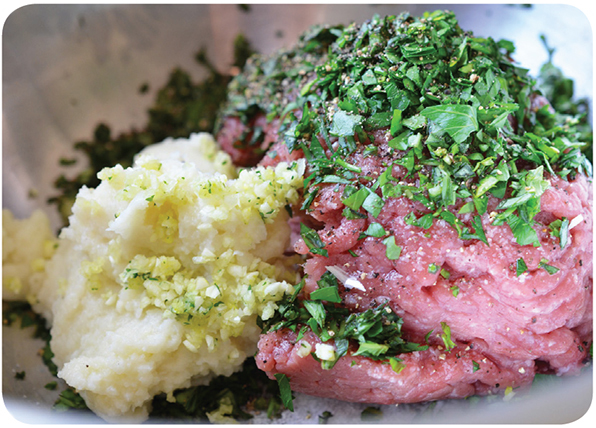
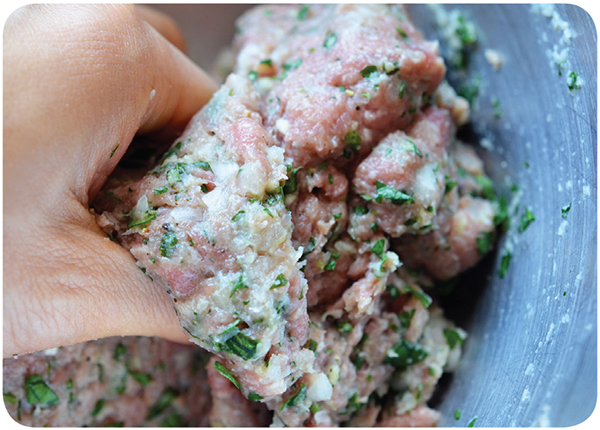
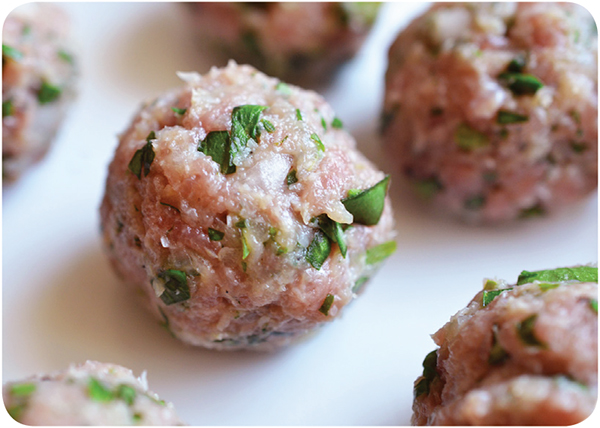
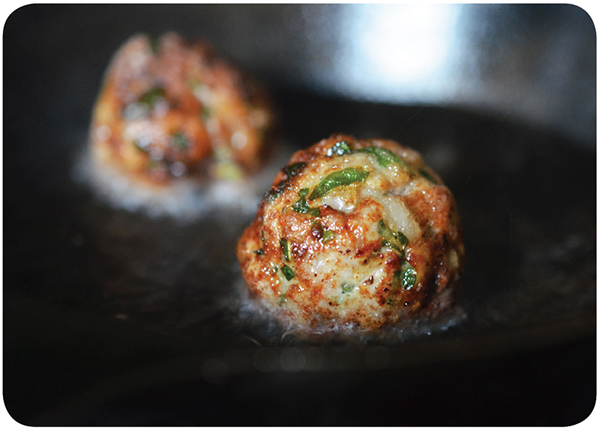
After stumbling home in the too-bright morning sunshine from another graveyard shift at the hospital, I just want to spend time with my little guys and then face-plant into my pillow. Prepping for dinner is the last thing on my mind. Fortunately, I can quickly toss some ingredients into my slow cooker and pass out, confident that I’ll wake up to the smell of a simmering pot of slow-cooked, Asian-spiced short ribs.
This recipe was inspired by the smarty-pants over at America’s Test Kitchen, who—in the course of making a similar dish—found that searing the meat in advance isn’t strictly necessary. The flavors will develop and intensify on their own in the slow cooker, so if you’re short on time, skip the browning and just throw everything into your slow cooker.
| Makes 4 servings | 6 pounds bone-in English-style beef short ribs | |
| Hands-on time: 15 minutes | Kosher salt | |
| Total time: 10 hours | Freshly ground black pepper | |
| 1 medium pear or Asian pear, peeled, cored, and chopped medium | ||
| ½ cup coconut aminos | ||
| 6 garlic cloves, smashed and peeled | ||
| 3 scallions, chopped medium | ||
| 1 (1-inch) piece fresh ginger, peeled and cut into coins | ||
| 2 teaspoons Paleo-friendly fish sauce | ||
| 1 tablespoon apple cider vinegar | ||
| 1 cup Bone Broth or stock of choice | ||
| ¼ cup minced fresh cilantro |
DO THIS:
You may want to make this dish ahead of time and store it in your fridge. During the cooking process, the short ribs will release a ton of fat into the gravy, which you can easily remove when the chilled fat hardens. 



Persian in origin, kabob koobideh was originally prepared by using a wooden mallet to hammer seasoned meat on a flat stone and cooking it on skewers. Modern versions are a tad less smash-tastic, but just as juicy, tender, and delicious. If you’ve got some ground beef or lamb in the fridge, these meat sticks are a fantastic change of pace. Just be sure to thoroughly knead the mixture of meat and finely minced onions, and use flat metal skewers (at least ⅜ inch wide) so these delicate kabobs will hold together and cook evenly.
| Makes 6 kabobs | 2 medium yellow onions, roughly chopped | |
| Hands-on time: 30 minutes | 2 pounds ground beef | |
| Total time: 4½ hours | 2 teaspoons kosher salt | |
| Freshly ground black pepper | ||
| 1 large egg | ||
| 1 teaspoon ground sumac (optional) |

DO THIS:
NO SKEWERS? NO GRILL? NO PROBLEM.
Fancy tools are fun, but these kabobs are just as tasty when broiled in the oven. Here’s how you can do it:
Instead of using skewers, carefully place the kabobs on a greased wire rack atop a foil-lined baking sheet. Broil the kabobs 6 inches from the heat source for 3 to 4 minutes on each side. Easy, right?




I love that there’s nothing fussy about Yankee pot roast. With roots in nineteenth-century New England, this one-pot comfort meal has never gone out of style. The basic formula has remained unchanged since the 1880s: sear off a cheap, tough cut of meat, and then slowly braise it with aromatics and broth until the roast is succulent and tender. Of course, that doesn’t mean our palates have to be stuck in the past. My version adds modern flair to this timeless classic, with a sweet balsamic reduction and bursts of umami that transcend eras and tastes. Mark my words: this ain’t your great-great-great-great-grandmother’s pot roast.
| Makes 6 servings | 1 (3½-pound) boneless beef chuck-eye roast | |
| Hands-on time: 30 minutes | Kosher salt | |
| Total time: 4 hours | Freshly ground black pepper | |
| 2 tablespoons ghee or fat of choice, divided | ||
| 3 leeks, white and light green ends only, cleaned, trimmed, and thinly sliced | ||
| 2 celery stalks, chopped medium | ||
| 2 medium carrots, chopped medium | ||
| 2 garlic cloves, smashed and peeled | ||
| 1 tablespoon tomato paste | ||
| ¼ cup balsamic vinegar | ||
| ½ ounce dried porcini mushrooms, soaked in hot water for 30 minutes, drained, and chopped medium | ||
| 2 sprigs fresh thyme | ||
| 2½ cups Bone Broth or stock of choice | ||
| ¼ cup chopped fresh Italian parsley |
DO THIS:
You'll love this with Garlic Mashed Cauliflower! 
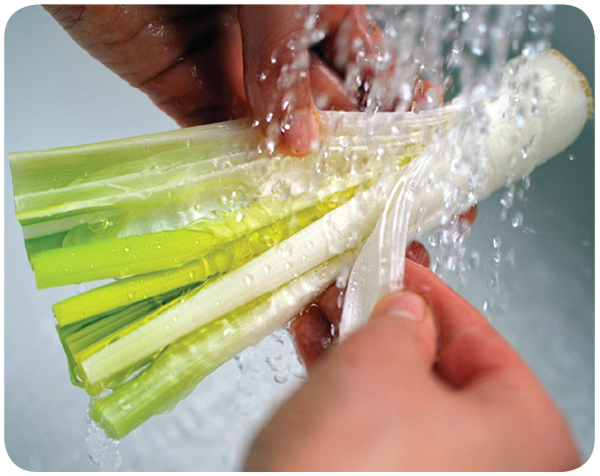
NO-FUSS, NO-MUSS LEEK CLEANING!
Your leeks may look clean, but there’s still plenty of dirt hidden in the folds. Here’s how you can quickly and easily clean a leek:
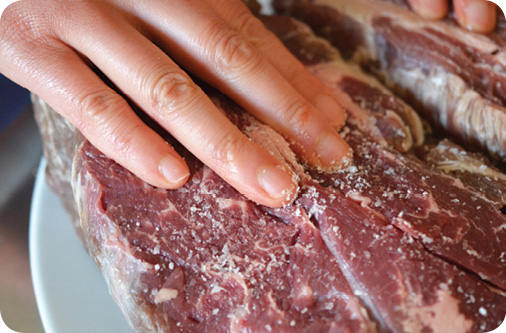
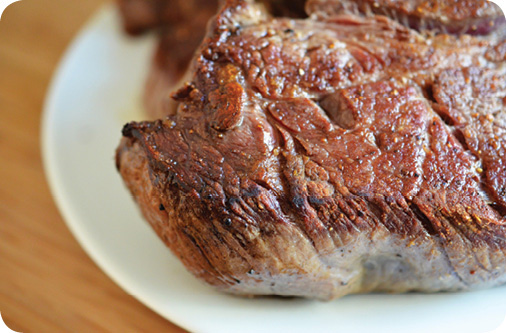


SMASHED STEAK SKEWERS + CHERRY BARBECUE SAUCE
Makes 16 skewers | Hands-on time: 45 minutes | Total time: 45 minutes
I rarely throw around the term “caveman diet.” As I mentioned earlier, in our house, we simply try to prioritize whole, nutrient-dense ingredients, and steer clear of foods that tend to be more harmful than healthful. Sadly, I’ve found that when the word “caveman” is associated with the way we eat, people tend to stare at us like we’re absolutely bonkers. (Which we are, but that’s beside the point.)
Still, embracing the “caveman” label can be a fun way to get the whole family into the spirit of Paleo chow. Take these smashed steak skewers: they’re simple, tasty, and kid-approved. I can’t think of anything more primal than speared hunks of meat, flattened with a heavy object and grilled over an open fire—can you?
GET:
Cherry Barbecue Sauce
2 teaspoons ghee or fat of choice
½ cup minced shallots
Kosher salt
1 garlic clove, minced
1 (1-inch) piece fresh ginger, peeled and finely grated (about 1 tablespoon)
1 tablespoon tomato paste
¼ cup coconut aminos
¼ cup balsamic vinegar
¼ cup apple juice
10 ounces pitted fresh or frozen dark sweet cherries, roughly chopped
Freshly ground black pepper
Smashed Steak Skewers
1 (1½-pound) flank steak
Kosher salt
Freshly ground black pepper
2 tablespoons melted ghee or fat of choice
¼ cup scallions, thinly sliced (optional)
DO THIS:
Grab some napkins 'cause this is gonna get MESSY! 

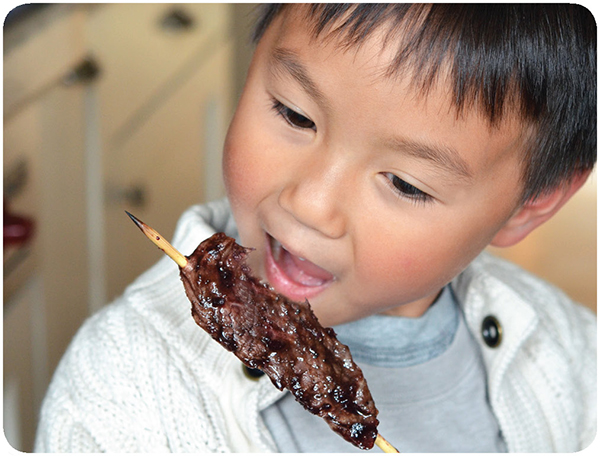
Makes 6 servings | Hands-on time: 45 minutes | Total time: 4 hours
GET:
1 (4-pound) beef chuck roast, cut into 2-inch cubes
2 teaspoons kosher salt
4 slices bacon, cut into ¼-inch pieces
1 medium yellow onion, cut into ½-inch dice
2 tablespoons tomato paste
¼ cup ancho chile powder
2 tablespoons ground cumin
1 tablespoon dried oregano
2 teaspoons smoked paprika
6 cups Bone Broth or chicken stock, divided
1 ounce unsweetened chocolate, shaved
4 garlic cloves, minced
Juice from 1 small lime
Freshly ground black pepper
½ medium white onion, cut into ¼-inch pieces (optional)
½ cup minced fresh cilantro (optional)
½ cup julienned radishes (optional)
2 small limes, quartered (optional)
During college, Henry and I worked at the same research institute on campus, and every summer, the staff organized a friendly chili cook-off. Most of the participants approached the contest with casual good humor, thinking only of kicking back with bowls of chili and cold bottles of beer in the California sunshine.
But not us. We were in it to win it.
My future husband and I spent days tinkering with our chili, adding and subtracting ingredients until we landed on what we thought was a sure winner: a spicy mélange of meat and peppers...and beans and corn.
And just to be sure that we’d emerge victorious, we badgered some friends into brazenly stuffing the ballot box in our favor. Our chili won by a hair, but it was a hollow victory—and not just because everyone was already on to our vote-rigging scheme. We knew our chili wasn’t the best submission.
The true winner was a pot of rich, meaty, no-bean stew, with fork-tender pieces of flavorful chuck roast and just the right balance of salt and heat. It’s been twenty years since the contest, but I still dream about that chili. After countless hours in the kitchen, this recipe is the closest I’ve come to replicating the dish that should’ve rightfully won that cook-off all those summers ago. If you’re anything like me, you won’t soon forget this Southwestern-style chili, with its smoky spices and tender chunks of beef.
DO THIS:
Chuck roast is ideal for slow-simmered chili, but in a pinch, ground beef will work, too! 


Bacon. Mushrooms. Beef. Dangerously good.
Makes 4 burgers | Hands-on time: 30 minutes | Total time: 30 minutes
GET:
2 tablespoons lard or fat of choice, divided
½ pound cremini mushrooms, minced
4 ounces bacon, frozen and cross-cut into small pieces
1 pound ground beef
1½ teaspoons kosher salt
Freshly ground black pepper
1 ripe heirloom tomato, sliced
4 butter lettuce leaves, rinsed and dried
8 whole Roasted Portobello Mushrooms (optional)
OPTIONAL TOPPINGS:
DO THIS:

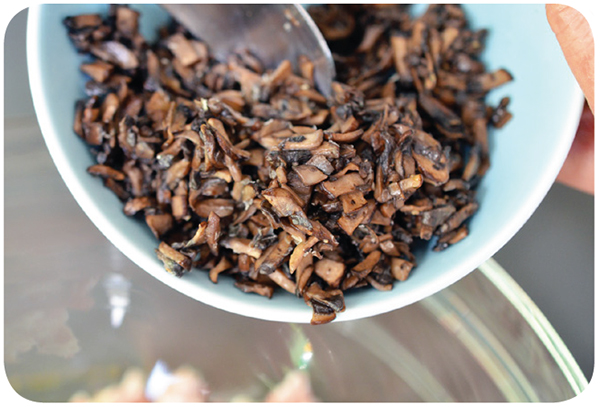




 A word to the wise: Make more than you think you'll need!
A word to the wise: Make more than you think you'll need!
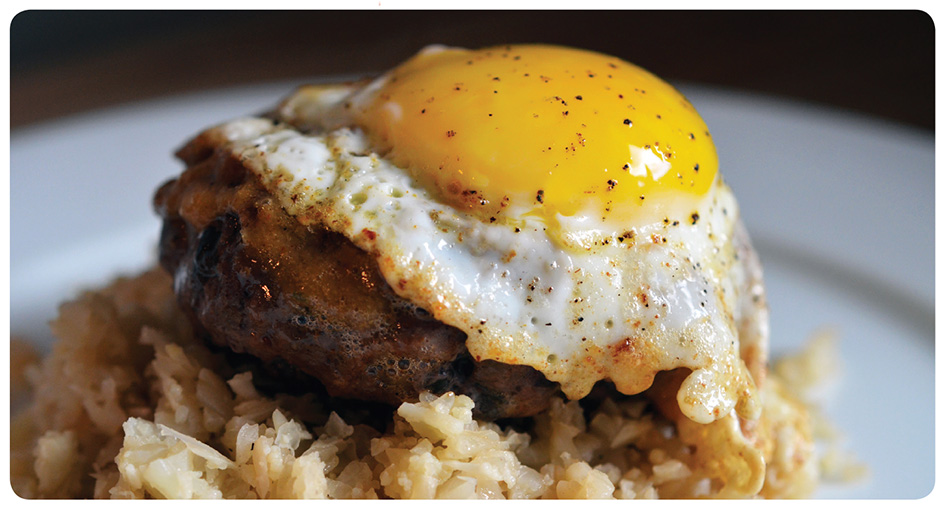
As you peer into your fridge, wondering what to make for dinner, your gaze lands on a carton of eggs and some leftovers: Easy Cauliflower “Rice,” Big-O Bacon Burgers, gravy from your Slow Cooker Chicken. Jackpot—the stars have aligned. Aloha, loco moco.
Loco moco combines hamburger patties, rice, brown gravy, and fried eggs to create a singularly rib-sticking plate of Hawaiian comfort food. Invented in the 1940s by a Hilo restaurant owner in response to requests from famished teenage customers, loco moco can now be found at virtually every roadside joint on the islands. And with any luck, the Paleo version of this ono grind will soon grace your table, too.
| Makes 2 servings | 2 large eggs | |
| Hands-on time: 15 minutes | 1 tablespoon ghee or fat of choice | |
| Total time: 15 minutes | Kosher salt | |
| Freshly ground black pepper | ||
| 2 cups Easy Cauliflower “Rice” or Coconut Pineapple “Rice” | ||
| ½ cup Caramelized Onions (optional) | ||
| 2 Big-O Bacon Burger patties, hot | ||
| ½ cup gravy from Slow Cooker Chicken + Gravy |
DO THIS:
 A fun garnish: chopped nori and a pinch of crushed red pepper flakes!
A fun garnish: chopped nori and a pinch of crushed red pepper flakes!
When it comes to properly cooking meats, I have notoriously high standards. I want my steaks and roasts to be perfectly pink and medium-rare from stem to stern—a result that’s difficult to accomplish without a sous-vide cooker. (This, of course, explains my obsession with my temperature-regulated water oven.)
But sous vide isn’t the only game in town. Ryan Farr of San Francisco’s 4505 Meats—who once spent an entire day patiently teaching me how to butcher a steer—is an advocate of slow, low-temperature roasting. There’s no need to purchase any counter-hogging equipment; with an oven and an in-oven thermometer, anyone can transform any big cut of meat into juicy, perfectly cooked protein.
Don’t believe me? Check out how easy it is to make roast beef (or beast, if you prefer) using Ryan’s method.
Convinced? Good, ’cause I want you to try two of my favorite ways to make mayo. Roll up your sleeves!
| Makes 6 servings | 1 (3-pound) beef eye of round roast | |
| Hands-on time: 15 minutes | Kosher salt | |
| Total time: 12 hours | ¼ cup Dukkah | |
| Freshly ground black pepper |
DO THIS:

I'm obsessed with my deli slicer, but a sharp knife and a steady hand are just as good! 

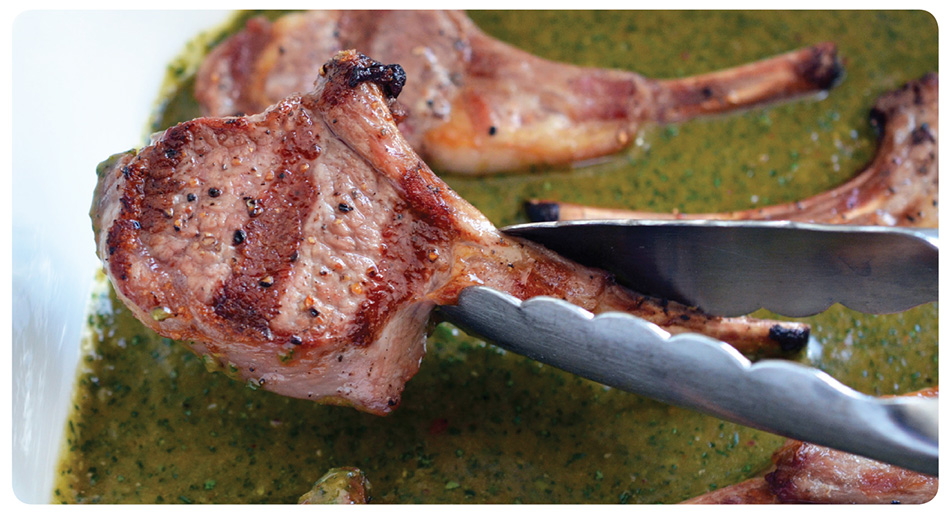
GRILLED LAMB CHOPS + MINT CHIMICHURRI
Makes 4 servings | Hands-on time: 30 minutes | Total time: 1 hour
The beauty of this recipe is that you don’t have to waste precious hours of your life marinating these lamb chops before it’s time to cook. Just pick up a couple of racks of lamb on your way home from work, and in about an hour, you’ll have a platter of zesty chops ready for your hungry clan. The secret? By resting your grilled lamb in a pool of minty chimichurri, the meat’ll soak up all the finger-lickin’ flavors in no time at all.
GET:
Grilled Lamb Chops
Kosher salt
16 lamb rib chops, frenched
Freshly ground black pepper
2 tablespoons ghee or fat of choice, melted
Mint Chimichurri
1 cup fresh parsley, chopped
½ cup fresh mint, chopped
¼ cup minced shallots
¼ cup balsamic vinegar
1 tablespoon salt-packed capers, soaked, rinsed, drained, and minced
1 teaspoon minced garlic cloves
¼ teaspoon crushed red chile flakes
Freshly ground black pepper
½ cup extra-virgin olive oil
DO THIS:
My kiddos call 'em LAMB LOLLIPOPS! 



Makes 8 servings | Hands-on time: 10 minutes | Total time: 16 hours
Once or twice a year, our family decamps to Hawaii—our home away from home. I love everything about the islands: the people, the pace, the climate, the beaches, the sunsets, the food.
Foremost among the Hawaiian dishes I crave? Kalua pig.
Often the headlining dish in a lu’au, kalua pig is the epitome of slow-roasted porky goodness. And I do mean slooow.
To make kalua pig the old school way, you first have to dig an imu—a big underground pit oven—and build a fire in it. Into the imu goes a whole pig, stuffed with hot volcanic rocks and wrapped in ti and banana leaves. The pig (pua’a in Hawaiian) is usually enveloped by chicken wire, too, so that once the pork is cooked and ready for removal, the fall-apart-tender meat stays together. The pua’a is then covered by burlap, a tarp, and a mound of dirt. Eight to ten hours of slow roasting (and a good amount of shoveling) later, dinner is served.
But something tells me that your local fire marshal is less than enthusiastic about you excavating part of your backyard so you can bury and cook a pig in it. So to keep you out of trouble, here’s a much less labor-intensive recipe for succulent, Hawaiian-style kalua pig. All you need are a few strips of bacon, a pork roast, Hawaiian sea salt, a slow cooker, and a little patience. The slow cooker helps retain all the juices of the meat, producing a roast pork that’s ridiculously tender and flavorful.
GET:
3 slices bacon
1 (5-pound) pork shoulder roast, bone-in or out (it doesn’t matter)
5 garlic cloves (optional)
1½ tablespoons coarse Alaea Hawaiian sea salt
ALAEA WHAT?
Coarse and unrefined, Alaea sea salt gets its deep terra-cotta hue from alae, a purified red volcanic clay that originated on the island of Kauai. The red clay is more mineral-rich than most salts, and imparts a subtle earthiness to dishes.
I stock up on Alaea salt whenever I visit Hawaii, but you don’t need to fly to paradise to get your hands on this wondrous ingredient—it’s widely available for purchase online.
Even if you don’t have any Alaea salt on hand, don’t fret. There’s nothing quite like the real thing, but in a pinch, any coarse salt will work.
DO THIS:
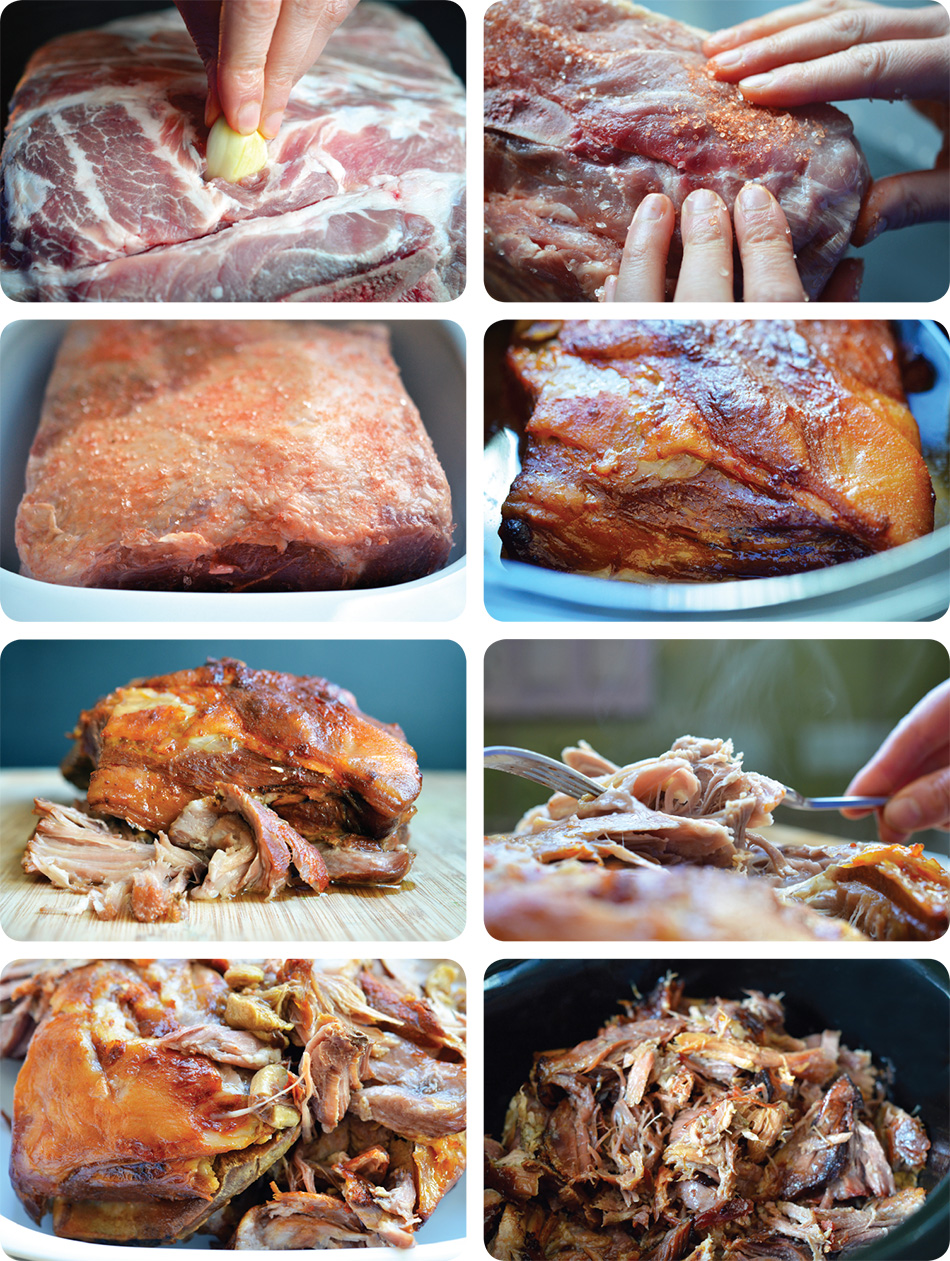
PUT THAT PIG TO WORK!
Juicy, tender slow cooker kalua pig is fantastic when served as-is, but it also makes for an incredibly versatile filling. I'm not kidding, folks: you can stick it in just about anything, and it'll be delicious.
Entertaining visitors for brunch? Make porky breakfast scrambles, omelets, or frittatas. Hosting a Mexican fiesta? Fill crisp lettuce tacos with savory kalua pig and top it with homemade guacamole and tomatoes. (Call it carnitas, and your guests won't be the wiser.)
And on those busy nights when you’re desperately in need of emergency protein (and wishing you were magically whisked away to Hawaii), just grab your leftover pork and toss it on a summer salad or wrap it in toasted sheets of nori. Dinner'll be on the table in no time at all! 

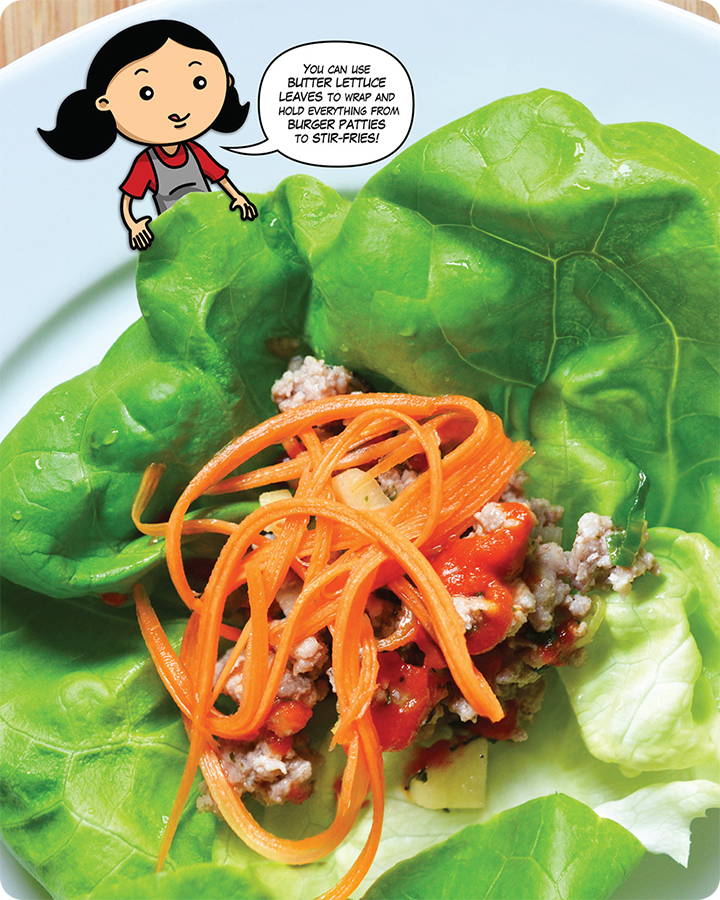
Blending Chinese and French influences, Vietnamese cuisine is pure alchemy; it balances and mixes flavors, textures, and temperatures to create unique, surprising dishes that pop.
This easy weeknight meal is a fantastic example. Scoop the steaming-hot filling into cool, crisp lettuce cups, add sweet-tart pickled carrot strings and a squirt of spicy sriracha, and get ready to be transported. Sure, this recipe requires some basic knife skills, but once your mise en place is set, it’ll take just minutes to get these wraps from wok to table.
| Makes 4 servings | 1 tablespoon coconut oil or fat of choice | |
| Hands-on time: 30 minutes | 1 small shallot, minced | |
| Total time: 30 minutes | Kosher salt | |
| 1 pound ground pork | ||
| 1 teaspoon minced fresh ginger | ||
| 1 garlic clove, minced | ||
| 1 teaspoon Paleo-friendly fish sauce | ||
| 2 teaspoons fresh lime juice | ||
| Freshly ground black pepper | ||
| ½ medium Golden Delicious apple, cut into ¼-inch dice | ||
| 2 scallions, thinly sliced | ||
| ¼ cup minced fresh cilantro | ||
| 1 teaspoon minced fresh mint | ||
| 2 tablespoons minced fresh basil | ||
| 1 head butter lettuce, leaves separated | ||
| Quick-Pickled Carrot Strings | ||
| Paleo Sriracha |
DO THIS:
In a large skillet or wok, melt the fat over medium heat. When it’s shimmering, add the shallot and a pinch of salt and sauté for about 3 minutes or until translucent. Toss in the ground pork and cook, stirring, until no longer pink. Add the ginger and garlic, and stir-fry until fragrant. Season with fish sauce, lime juice, and pepper. Remove from heat, add the apple and minced herbs, and stir to combine. Serve in individual butter lettuce leaves with a garnish of pickled carrot and sriracha.
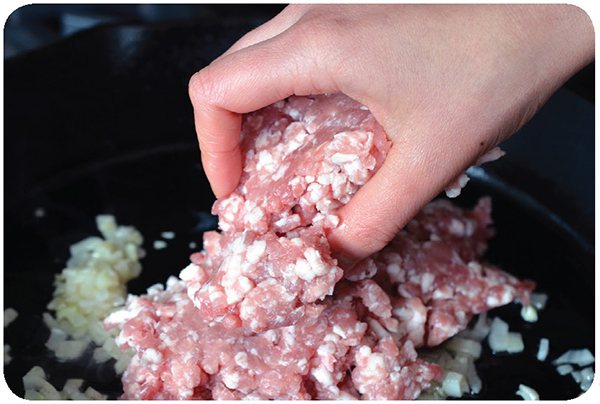
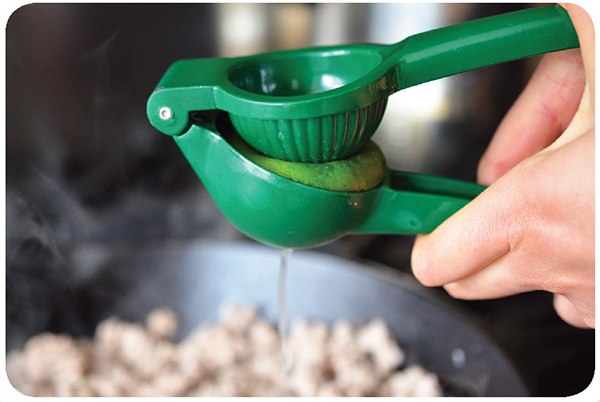

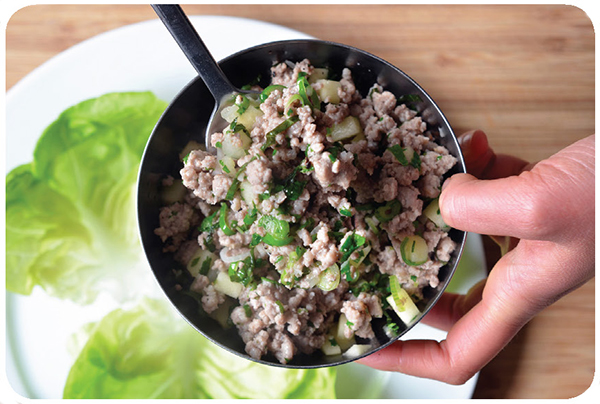

No sriracha on hand? Top with thin slices of jalapeño pepper instead! 
Don’t you think it’s time to throw away that box of chemically enhanced, frostbitten sausage pucks buried in the back of your icebox? It’s not hard to make your own, you know. Seasoned with fresh herbs and a dash of maple syrup, these hearty homemade breakfast patties are the perfect way to start your day.
| Makes 16 patties | 2 pounds ground pork | |
| Hands-on time: 30 minutes | 2 tablespoons maple syrup | |
| Total time: 30 minutes | 1 tablespoon kosher salt | |
| 1 teaspoon freshly ground black pepper | ||
| 2 teaspoons minced fresh sage | ||
| 1 teaspoon minced fresh thyme | ||
| ½ teaspoon minced fresh rosemary | ||
| ½ teaspoon ancho chile powder | ||
| 2 tablespoons ghee or fat of choice |

DO THIS:
CHEW ON THIS:
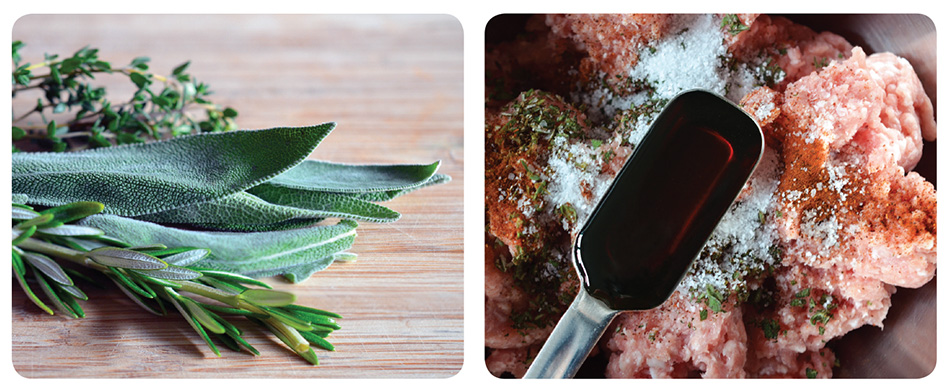
 Wanna make Paleo Sausage Egg Muffin sandwiches for breakfast? Visit me at NomNomPaleo.com for the recipe!
Wanna make Paleo Sausage Egg Muffin sandwiches for breakfast? Visit me at NomNomPaleo.com for the recipe!
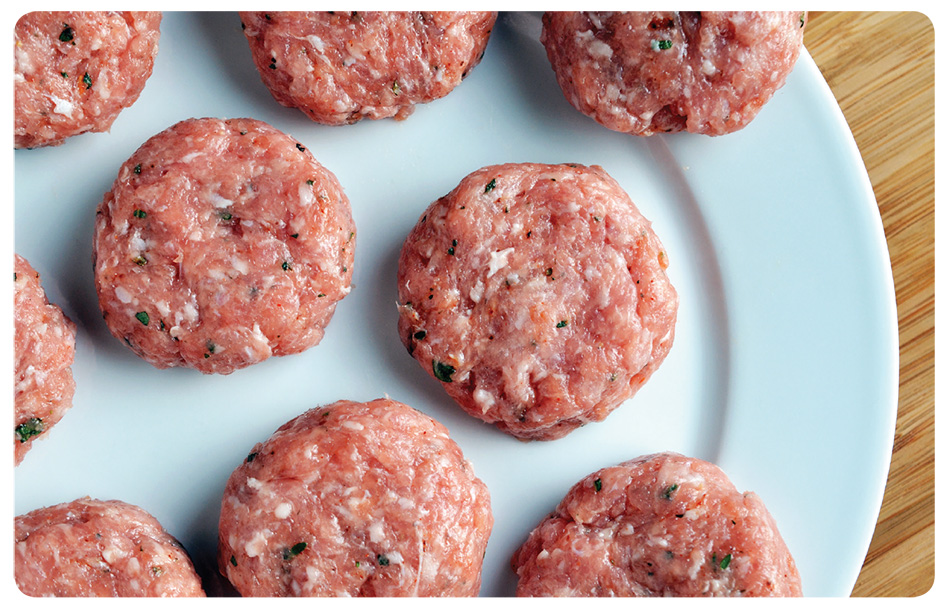
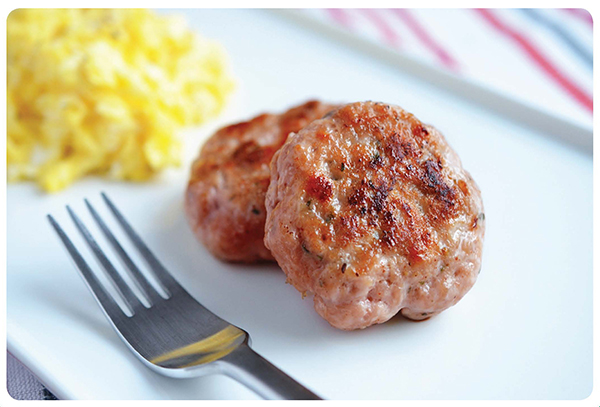
BRINNER is breakfast for dinner! Scramble some eggs with a generous pinch of Magic Mushroom Powder, and throw some Maple Sausage Patties on the side! 
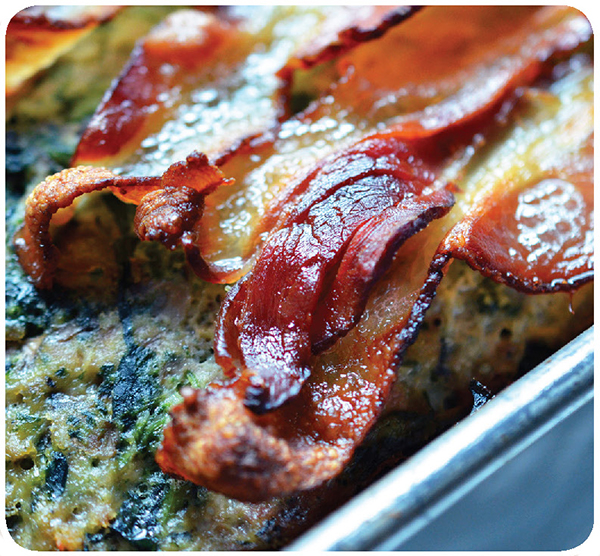
This tender, flavorful, porky loaf was a clear-cut winner the very first time I made it. Don’t believe me? My (then) six-year-old declared that this dish merited “FIVE STARS!” and demanded seconds. But then again, just like all of us, he has a special place in his heart for just about anything topped with bacon.
| Makes 6 servings | 1 tablespoon ghee or fat of choice | |
| Hands-on time: 30 minutes | 1 small yellow onion, cut into ½-inch dice | |
| Total time: 2 hours | ½ pound cremini mushrooms, minced | |
| 2 medium celery stalks, chopped medium | ||
| ½ cup loosely packed fresh Italian parsley | ||
| ¼ cup coconut cream | ||
| 1 pound ground pork | ||
| 1 pound frozen chopped spinach, thawed and squeezed dry | ||
| ¼ cup coconut flour | ||
| 1 teaspoon kosher salt | ||
| 1½ teaspoons freshly ground black pepper | ||
| ¼ teaspoon freshly grated nutmeg | ||
| 1 garlic clove, minced | ||
| 2 large eggs, lightly beaten | ||
| 5 bacon slices | ||
| Marinara sauce, warmed, for serving (optional) |
DO THIS:
 Do you prefer a moister, lighter-textured meatloaf? Try substituting a quarter-cup of Garlic Mashed Cauliflower in place of the coconut flour!
Do you prefer a moister, lighter-textured meatloaf? Try substituting a quarter-cup of Garlic Mashed Cauliflower in place of the coconut flour!

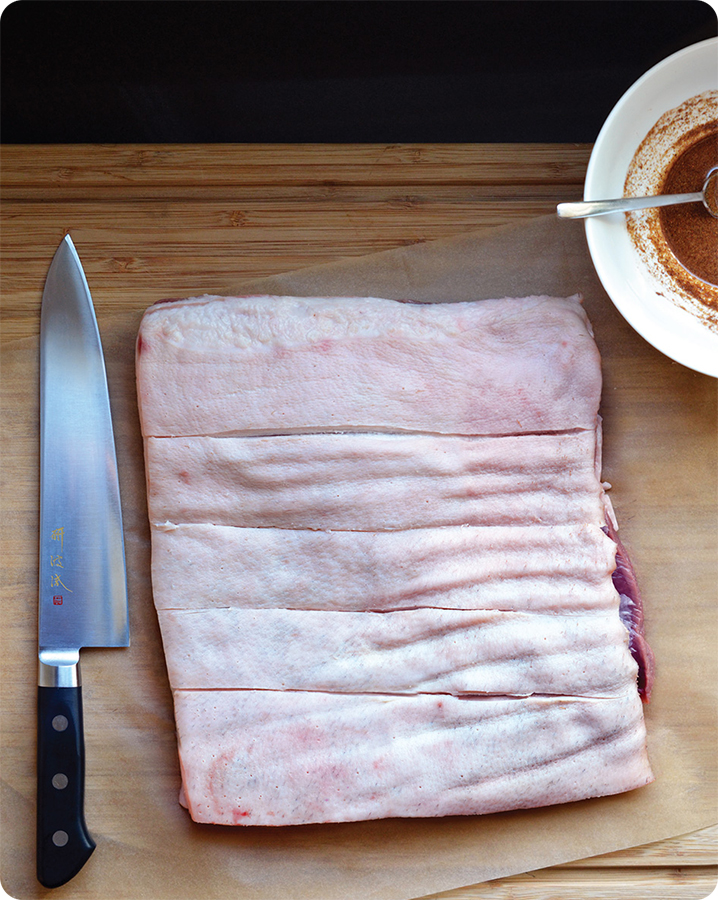
SIU YOKE (CRISPY ROAST PORK BELLY)
Makes 8 servings | Hands-on time: 45 minutes | Total time: 12 hours
Whenever I spy a slab of crisp roast pork belly hanging in the window of a Chinese barbecue joint, I start salivating. With a crackling-crisp golden-orange exterior and a lusciously succulent and juicy interior, Chinese siu yoke is every bit as smashing as it looks. Best of all, with just a bit of time and effort, you won’t even need to brave the Chinatown crowds to enjoy this utterly authentic version at home.
GET:
Roast Pork
1 (4-pound) pork belly
1½ tablespoon baking soda
1 quart boiling water, plus more for roasting
½ teaspoon kosher salt
Siu Yoke Marinade
2 teaspoons five spice powder
2 tablespoons kosher salt
2 tablespoons apple cider vinegar
1 tablespoon Paleo-friendly fish sauce
1 tablespoon honey
DO THIS:

Hong Kong: Home of the world's best siu yoke!

As a boy, Henry called the siu yoke skin "BOK-BOK" due to its audibly crunchy pop when you take a bite. We tease him mercilessly about it. 
